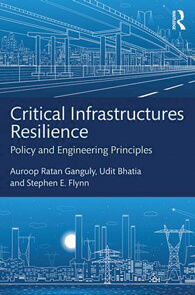Book Review: Critical Infrastructures Resilience: Policy and Engineering Principles
By Auroop Ratan Ganguly, Udit Bhatia, and Stephen E. Flynn. Routledge; 132 pages; $86.95.
 More than 85 percent of critical infrastructures are owned and operated by the private sector. It is imperative that intelligence and law enforcement agencies collaborate directly with the private sector to better prepare for crises that could occur to critical infrastructures today.
More than 85 percent of critical infrastructures are owned and operated by the private sector. It is imperative that intelligence and law enforcement agencies collaborate directly with the private sector to better prepare for crises that could occur to critical infrastructures today.
Critical Infrastructures Resilience: Policy and Engineering Principles offers several resiliency-based planning strategies that focus on global critical infrastructures. The three authors have extensive expertise in the areas of engineering, machine learning, climate change, homeland security, and public policy. Their combination of practical experience and academic expertise has created a publication that fills a gap between engineering principles and resilience-based planning.
The U.S. Department of Homeland Security (DHS) outlines 16 core critical infrastructure sectors; these are briefly cited in Chapter 1. The authors move on to discuss resiliency and risk management across other sectors, organizations, and industries in the public and private areas. The DHS and academic researchers have determined that resiliency-based and reactionary-based planning strategies and techniques can be shared from one sector to another. The text should have made that connection.
This book offers valuable tables, figures, data, charts, models, and science-based methods that are used to support the authors’ statements. The resources allow the experts to predict certain scenarios using proven models for infrastructure systems and effective strategies that devise a clear path to quantifying resilience.
One shortcoming of the book is that it focuses only on resiliency, resiliency-
based planning, risk assessment, and vulnerability analysis without reference to reactionary-based planning. Recovery is a crucial step in the reactionary process. Many of the lessons learned from an incident during recovery can be applied to resiliency-based planning techniques and strategies to help prevent incidents from reoccurring.
The authors overlook cybersecurity threats to critical infrastructures, which all depend to some extent on computers, artificial intelligence, and other technologies. A major cyber breach could be catastrophic. They also miss a chance to provide supplemental material for classroom activities. Additional content could stimulate further critical thinking among readers and students.
Ultimately, Critical Infrastructures Resilience: Policy and Engineering Principles is well-written, researched, and presented. It is a great scholarly contribution to the engineering and security sectors, and it underscores the valuable lesson of Risk = Hazard x Vulnerability x Exposure.
Reviewer: Thomas Rzemyk, Ed.D., has experience in criminal justice, homeland security, security management, international security, cybersecurity, and counterterrorism. He is a criminology discipline reviewer in the Fulbright Scholar Program.